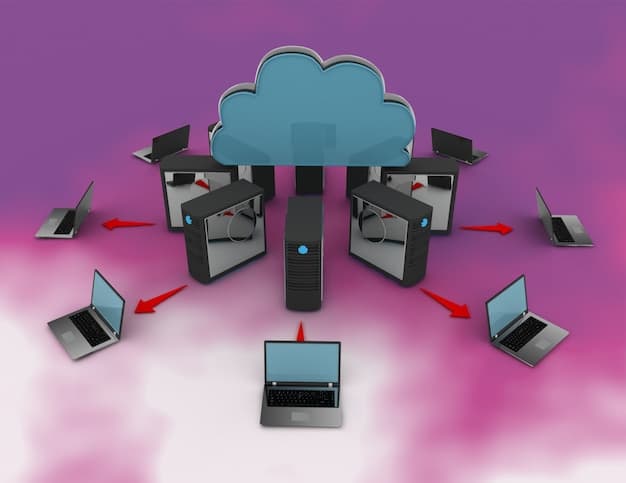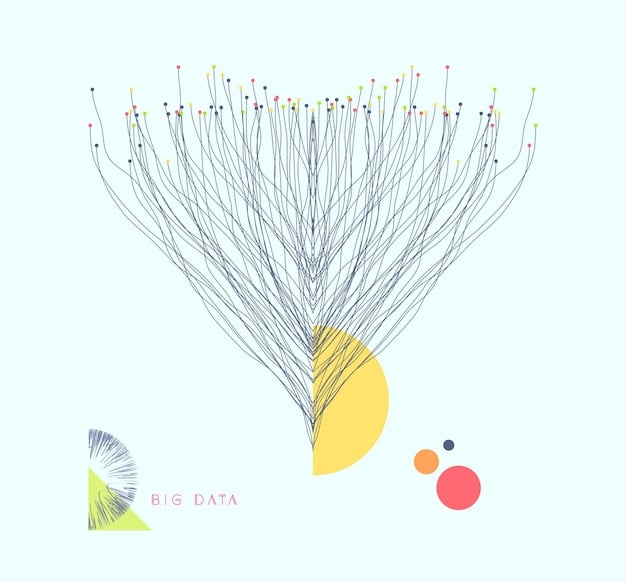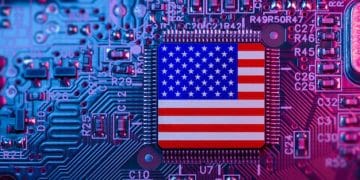Optimize AI Models for Edge Computing: A US Developer’s Guide

How to Optimize Your AI Model for Edge Computing is a critical guide for US developers aiming to deploy efficient AI solutions on edge devices, covering techniques like model compression, quantization, and hardware acceleration for enhanced performance and reduced latency.
Deploying Artificial Intelligence (AI) models at the edge offers unparalleled opportunities for real-time data processing and enhanced user experiences. However, effectively optimizing your AI model for edge computing is critical for US developers looking to harness the full potential of edge devices.
Understanding the Edge Computing Landscape
Edge computing brings computation and data storage closer to the source of data, reducing latency and bandwidth usage. For US developers, understanding the nuances of this landscape is key to successful AI deployment.
Benefits of Edge AI
Edge AI offers several advantages over cloud-based AI solutions. These benefits make it an attractive option for numerous applications, especially where real-time processing is crucial.
- Reduced Latency: Edge AI minimizes latency by processing data locally, enabling quicker response times.
- Increased Privacy: Sensitive data remains on-device, enhancing privacy and security.
- Bandwidth Efficiency: Less data transmission reduces bandwidth consumption and costs.
- Improved Reliability: Edge devices can operate independently, even without a constant network connection.
By understanding these advantages, US developers can make informed decisions about when and how to implement AI at the edge.

Challenges in Edge AI
Despite its benefits, deploying AI models at the edge presents unique challenges for US developers. Overcoming these hurdles requires careful planning and optimization. The scarcity of resources found in edge locations offers an interesting challenge.
- Resource Constraints: Edge devices often have limited processing power, memory, and battery life.
- Model Size: Large AI models can be too complex to run efficiently on edge devices.
- Power Consumption: Energy efficiency is crucial for battery-powered edge devices.
Successfully addressing these challenges is essential for deploying high-performing AI solutions at the edge. Overcoming them is more about creativity than anything else.
In conclusion, edge computing offers significant advantages for AI applications, US developers must understand both the benefits and challenges involved. Addressing these challenges allows you to fully take advantage of the system and unlock AI at the edge.
Model Compression Techniques
Model compression is a cornerstone technique for optimizing AI models for edge computing. US developers can use these methods to reduce model size and complexity without significant performance loss.
Quantization
Quantization reduces the precision of model weights and activations, leading to smaller model sizes and faster inference times. There are things you should be aware of, though.
By reducing the number of bits required to represent each parameter, quantization can significantly decrease the memory footprint and computational requirements of AI models.
Pruning
Pruning involves removing unimportant connections or weights from the neural network. This process reduces model size and complexity, improving inference speed.
US developers can use pruning to eliminate redundant parameters, resulting in a more efficient and streamlined model architecture. This will improve efficiency greatly and reduce workload.

Knowledge Distillation
Knowledge distillation transfers knowledge from a large, complex model (teacher) to a smaller, simpler model (student). This technique enables the student model to achieve comparable performance with significantly fewer parameters.
US developers can use knowledge distillation to create lightweight edge models that retain the accuracy of their larger counterparts.
In summary, model compression techniques such as quantization, pruning, and knowledge distillation helps US developers reduce the size and complexity of AI models to make it easier to increase efficiency.
Hardware Acceleration for Edge Devices
Leveraging hardware acceleration is vital for achieving optimal performance on edge devices. US developers can take advantage of specialized hardware to accelerate AI inference.
GPUs and TPUs
Graphics Processing Units (GPUs) and Tensor Processing Units (TPUs) are designed to accelerate matrix operations, which are fundamental to deep learning. There is a wide variety of these available in today’s market.
- Parallel Processing: GPUs excel at parallel processing, making them well-suited for accelerating AI tasks.
- Tensor Operations: TPUs are specifically designed for tensor operations, offering even greater performance for certain AI models.
US developers can use GPUs and TPUs to significantly improve the inference speed of their edge AI models.
FPGAs
Field-Programmable Gate Arrays (FPGAs) offer a flexible hardware platform that can be customized to accelerate specific AI algorithms. This can drastically improve the edge AI model, too.
By configuring FPGAs to match the computational requirements of their AI models, US developers can achieve high performance and energy efficiency.
Optimized Hardware Libraries
Many hardware vendors provide optimized libraries for AI inference. These libraries are tailored to specific hardware architectures, offering improved performance and efficiency.
By using these libraries, US developers can unlock the full potential of their edge devices and accelerate AI inference.
In conclusion, hardware acceleration is a critical component of edge AI optimization. US developers can consider GPUs, TPUs, FPGAs, and optimized hardware libraries to maximize the performance.
Frameworks and Tools for Edge AI Development
Several frameworks and tools are available to streamline the development and deployment of AI models on edge devices. US developers can leverage these resources to accelerate their edge AI projects.
TensorFlow Lite
TensorFlow Lite is a lightweight version of TensorFlow designed for mobile and embedded devices. It provides tools for model conversion, optimization, and deployment.
US developers can use TensorFlow Lite to deploy TensorFlow models on a wide range of edge devices, including smartphones, microcontrollers, and IoT devices.
PyTorch Mobile
PyTorch Mobile allows developers to run PyTorch models on mobile and edge devices. It offers tools for model optimization and a streamlined deployment process.
US developers can use PyTorch Mobile to leverage the flexibility and power of PyTorch for their edge AI applications.
ONNX Runtime
ONNX Runtime is a cross-platform inference engine that supports a wide range of AI models. It can be used to deploy models trained in various frameworks, including TensorFlow, PyTorch, and scikit-learn.
US developers can use ONNX Runtime to achieve high performance and portability across different edge devices.
Practical Implementation Steps
Implementing AI models at the edge requires a systematic approach. US developers can follow these practical steps to ensure successful deployment.
Step 1: Profile Your Model
Before optimizing your model, profile its performance on the target edge device. Identify bottlenecks and areas for improvement.
US developers can use profiling tools to measure the execution time of different operations and pinpoint the most computationally expensive parts of the model.
Step 2: Apply Model Compression Techniques
Use model compression techniques to reduce the size and complexity of your AI model. Quantization, pruning, and knowledge distillation are effective methods.
US developers should experiment with different compression techniques to find the optimal trade-off between model size, performance, and accuracy.
Step 3: Optimize for Hardware
Leverage hardware acceleration to improve the inference speed of your AI model. Use optimized hardware libraries and consider deploying on GPUs, TPUs, or FPGAs.
US developers should tailor their optimizations to the specific hardware capabilities of the target edge device.
Step 4: Deploy and Monitor
Deploy your optimized AI model on the edge device and monitor its performance in real-world conditions. Collect data to identify further areas for optimization.
US developers should continuously monitor model performance and adapt their optimization strategies as needed.
Use Cases for Edge AI in the US Market
Edge AI is transforming various industries in the US market. Here are a few compelling use cases.
Autonomous Vehicles
Edge AI enables autonomous vehicles to process sensor data in real-time, making quick decisions without relying on a cloud connection. This is a massive improvement over traditional solutions.
- Object Detection: Edge AI algorithms can identify and classify objects in the vehicle’s surroundings, such as pedestrians, other vehicles, and traffic signs.
Smart Manufacturing
Edge AI helps manufacturers monitor equipment health, detect anomalies, and optimize production processes in real-time.
- Predictive Maintenance: Edge AI models can analyze sensor data to predict when equipment is likely to fail, enabling proactive maintenance and reducing downtime.
Healthcare
Edge AI enables medical devices to perform real-time analysis of patient data, improving diagnostic accuracy and enabling personalized treatment.
- Remote Patient Monitoring: Edge AI algorithms can analyze data from wearable sensors to monitor patients’ health remotely and detect potential health issues early on.
| Key Aspect | Brief Description |
|---|---|
| 🚀 Model Compression | Reduces size/complexity without significant performance loss. |
| ⚙️ Hardware Acceleration | Utilizes GPUs, TPUs, and FPGAs for optimal performance. |
| 🛠️ Frameworks & Tools | Employs TensorFlow Lite, PyTorch Mobile, ONNX Runtime. |
| 📊 Monitoring & Optimization | Continuously track performance and refine strategies for efficiency. |
Frequently Asked Questions
▼
Edge computing brings computation closer to the data source, reducing latency and bandwidth needs. This is crucial for AI applications needing real-time processing and enhanced privacy, such as autonomous vehicles and remote patient monitoring.
▼
Common model compression techniques include quantization, which reduces the precision of model weights; pruning, which removes unimportant connections; and knowledge distillation, which transfers knowledge from a large model to a smaller one. All of these are valuable to utilize.
▼
Hardware acceleration uses specialized processors like GPUs, TPUs, and FPGAs to speed up AI inference. These processors are designed for parallel processing and tensor operations, significantly improving the computational efficiency of AI models.
▼
Popular frameworks for edge AI development include TensorFlow Lite, which is designed for mobile and embedded devices; PyTorch Mobile, which allows running PyTorch models on edge devices; and ONNX Runtime, which supports a variety of AI models across different platforms.
▼
The key steps include profiling the model on the target device to identify bottlenecks, applying model compression techniques to reduce size, optimizing for hardware by leveraging acceleration tools, and continuously monitoring performance after deployment.
Conclusion
Optimizing AI models for edge computing is essential for US developers looking to harness the benefits of real-time data processing, reduced latency, and enhanced privacy. By understanding the edge computing landscape, applying model compression techniques, leveraging hardware acceleration, and following practical implementation steps, developers can successfully deploy high-performing AI solutions on edge devices.





